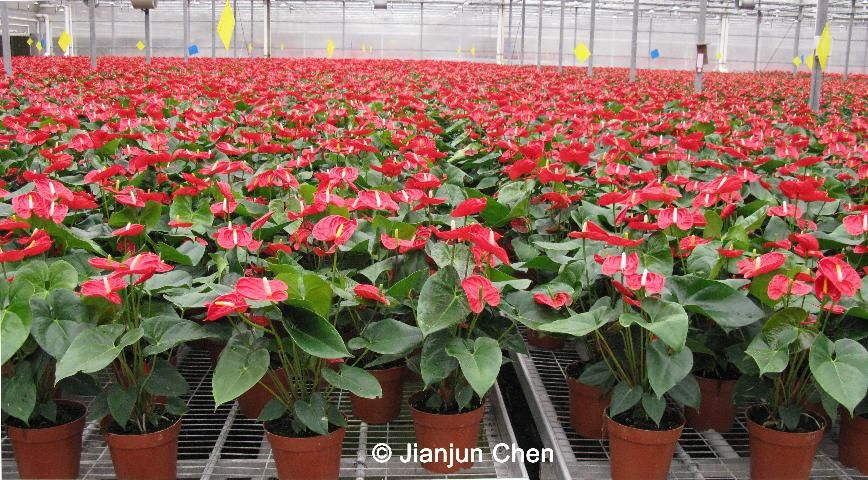Anthurium is the largest genus in the family Araceae, encompassing more than 800 species native to tropical America, from Mexico, Costa Rica, and Cuba to Brazil and Argentina. Growth habit varies depending on species, as some are climbing hemi-epiphytes, others are terrestrial, and still others are epiphytes. The common names of Tailflower, Cresta de Gallo, Cockscomb, Flamingo Flower, Hawaiian Love Plant, and Tongue of Fire attest to the beauty of most Anthurium species' colorful and long-lasting inflorescences consisting of brightly colored spathes and contrasting or complementary spadices. A few commercially grown plants are classified as "rat tail" Anthuriums as their inflorescences have a long spadix and a small non-descript spathe.
Traditionally, Anthuriums with colorful inflorescences have been grown for cut flowers. With the introduction of compact interspecific hybrids through breeding and the selection of somaclonal variants, a series of potted Anthurium cultivars have been released in Florida, Hawaii, and the Netherlands. Florida is now the leading state in the nation in the production of potted flowering Anthurium. The intent of this article is to describe common species and cultivars in the foliage plant industry (See Table 1), provide guidelines for their culture and interior use, and list physiological problems that may be encountered during production and interiorscape use (See Table 3).

Cultural Guidelines
Propagation
Anthurium can be propagated by seed or division, but almost all cultivars are now propagated through tissue culture. Plantlets from tissue culture are grown in medium-filled, multi-cavity plastic liner trays. Rooting is best in well-aerated potting mixes of 1:1:1 peat, perlite, and bark. Mixes can also include wood shavings, fern slips, coffee parchment, rockwell, foam, macadamia shells, volcanic cinder, or taro peel. Substrate pH should be between 6.0 and 6.5, air temperatures between 70 and 90°F, and relative humidity should be high for best growth.
Production
Anthurium should be produced in container media with good drainage. Examples are: 1:1:1 Canadian peat, perlite, and bark or 50% Canadian peat, 20% styrofoam, 20% course vermiculate, and 10% pine bark with pH 6.0 to 6.5 and soluble salts 1 to 2 dS/m. Typical light levels range from 1,000 to 2,500 foot candles or 90% to 80% shade in Florida. Higher than that can cause pale leaf color, which is often misdiagnosed as a nutrient deficiency.
Controlled-release fertilizers, water-soluble fertilizers, or combinations of both have been used for Anthurium production. Generally, 2.5 to 3.0 lb N per 1,000 ft2 per month should be the optimal rate for high quality plant production. Growers may use a fertilizer with N-P2O5-K2O at 3-1-2 ratio at the beginning of production, then shift to a fertilizer with N-P2O5-K2O at 1-2-2 ratio to promote flowering. Growers are recommended to monitor media soluble salts and pH every 2 or 3 weeks using the pour-through method. Information about the pour-through method can be found at https://edis.ifas.ufl.edu/pdffiles/EP/EP07400.pdf. If the soluble salts reading is 1 dS/m, the plant will show nutrient deficiency if no additional fertilizer is provided; if the soluble salts reading is 2 dS/m, nutrient levels are adequate; and if the reading is 3 dS/m or above, reduce either the rate or frequency of fertilizer application. In some cases, leaching the media with water is necessary to reduce soluble salts buildup. Table 2 provides a guide for determining if Anthurium cultivars are appropriately fertilized based on leaf analysis.
Drip- or sub- irrigation is recommended for Anthurium production. Do not allow fertilizer to splash onto the foliage, as it will leave a grey residue. The optimal temperature for Anthurium growth is 70 to 90°F. Keep air temperatures above 55°F, otherwise visible or invisible damage may occur, and plant growth will be delayed when temperatures return to appropriate levels.
Shipping and Interior Care
Shipping temperatures must be kept between 55 and 60°F. A sleeve is recommended for shipping to protect leaves and inflorescences. Use caution when handling Anthurium as their sap tends to be slightly irritating.
Once finished plants are placed in the interior setting, allow them to dry slightly between waterings. When it is time to water, do so thoroughly. Misting with water is also recommended to dislodge dust and temporarily increase relative humidity. A supply of a 20-20-20 water-soluble fertilizer solution with a N level at 50 ppm once a month should be adequate under interior conditions. Check the media soluble salts level using the pour-through method. A reading between 0.8 and 1.2 dS/m should be appropriate. Overfertilization indoors will cause soluble salts buildup and thus leaf marginal or tip injury. Remove expired flowers as needed. Maintain interior temperatures between 70 and 85°F. Avoid drafts and excessive heat or cold, especially from appliances such as televisions and refrigerators.
Our recent study of Anthurium cultivars showed that several cultivars are able to flower continuously under interior light levels of 100 foot candles for over one and a half years. Potted Anthuriums are true interior flowering foliage plants and have advantages over potted plants such as chrysanthemums and poinsettias due to their unique appearance, long-lasting flowers, continuous growth, and flowering under interior conditions. It is anticipated that more potted Anthurium cultivars will be introduced to the foliage plant and interior plantscape industries and that Anthurium will continue to increase in value as a flowering foliage plant.